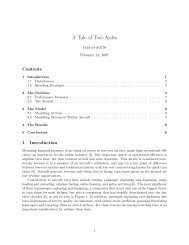Neural Models of Bayesian Belief Propagation Rajesh ... - Washington
Neural Models of Bayesian Belief Propagation Rajesh ... - Washington
Neural Models of Bayesian Belief Propagation Rajesh ... - Washington
You also want an ePaper? Increase the reach of your titles
YUMPU automatically turns print PDFs into web optimized ePapers that Google loves.
11.5 Discussion 255<br />
the neural population, it becomes harder to map inference algorithms such as<br />
belief propagation to neural circuitry.<br />
Hierarchical Inference<br />
There has been considerable interest in neural implementation <strong>of</strong> hierarchical<br />
models for inference. Part <strong>of</strong> this interest stems from the fact that hierarchical<br />
models <strong>of</strong>ten capture the multiscale structure <strong>of</strong> input signals such as images in<br />
a very natural way (e.g., objects are composed <strong>of</strong> parts, which are composed <strong>of</strong><br />
subparts,..., which are composed <strong>of</strong> edges). A hierarchical decomposition <strong>of</strong>ten<br />
results in greater efficiency, both in terms <strong>of</strong> representation (e.g., a large number<br />
<strong>of</strong> objects can be represented by combining the same set <strong>of</strong> parts in many<br />
different ways) and in terms <strong>of</strong> learning. A second motivation for hierarchical<br />
models has been the evidence from anatomical and physiological studies that<br />
many regions <strong>of</strong> the primate cortex are hierarchically organized (e.g., the visual<br />
cortex, motor cortex, etc.).<br />
Hinton and colleagues investigated a hierarchical network called the<br />
Helmholtz machine [16] that uses feedback connections from higher to lower<br />
levels to instantiate a probabilistic generative model <strong>of</strong> its inputs (see also [18]).<br />
An interesting learning algorithm termed the “wake-sleep” algorithm was proposed<br />
that involved learning the feedback weights during a “wake” phase<br />
based on inputs and the feedforward weights in the “sleep” phase based on<br />
“fantasy” data produced by the feedback model. Although the model employs<br />
feedback connections, these are used only for bootstrapping the learning <strong>of</strong> the<br />
feedforward weights (via fantasy data). Perception involves a single feedforward<br />
pass through the network and the feedback connections are not used for<br />
inference or top-down modulation <strong>of</strong> lower-level activities.<br />
A hierarchical network that does employ feedback for inference was explored<br />
by Lewicki and Sejnowski [22] (see also [17] for a related model). The<br />
Lewicki-Sejnowski model is a <strong>Bayesian</strong> belief network where each unit encodes<br />
a binary state and the probability that a unit’s state Si is equal to 1 depends on<br />
the states <strong>of</strong> its parents pa[Si] via:<br />
P (Si = 1|pa[Si], W ) = h( <br />
wjiSj), (11.47)<br />
j<br />
where W is the matrix <strong>of</strong> weights, wji is the weight from Sj to Si (wji = 0 for<br />
j < i), and h is the noisy OR function h(x) = 1 − e −x (x ≥ 0). Rather than<br />
inferring a posterior distribution over states as in the models presented in this<br />
chapter, Gibbs sampling is used to obtain samples <strong>of</strong> states from the posterior;<br />
the sampled states are then used to learn the weights wji.<br />
Rao and Ballard proposed a hierarchical generative model for images and<br />
explored an implementation <strong>of</strong> inference in this model based on predictive<br />
coding [34]. Unlike the models presented in this chapter, the predictive coding<br />
model focuses on estimating the MAP value <strong>of</strong> states rather than an entire<br />
distribution. More recently, Lee and Mumford sketched an abstract hierarchical<br />
model [21] for probabilistic inference in the visual cortex based on an
















